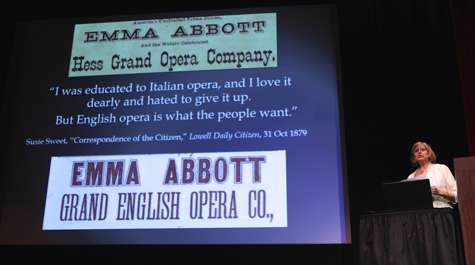Preston at Tack: Americans once loved opera, on their own terms
If you’re American, chances are you aren’t much into opera. In fact, pressed to come up with an opera reference, you’re likely to think Elmer Fudd belting out, “Kill da wabbit!” to the tune of “Ride of the Valkyries.”
But it wasn’t always so, Katherine K. Preston, Margaret N. and David C. Bottoms Professor of Music at William & Mary, told an audience of about 300 people gathered at the Kimball Theatre on Wednesday for her Tack Faculty Lecture, “An American Prima Donna and Apple-Pie Opera.” There was a time when the same kind of people who today religiously tune in to “Dancing with the Stars” were passionate about opera.
{{youtube:medium:left|zvqtmoGq4Qw}}
In fact, up through the Civil War, opera was one of the theatre offerings that Americans of all stripes relied on for entertainment, alongside drama, ballet, black-face minstrelsy, acrobatics and the like.
“I'm not suggesting by this that our forefathers or foremothers were somehow more cultured or sophisticated,” Preston said. “Rather, I'm suggesting our image of opera, or the function of opera, has changed. Then, they thought of it as entertainment.”
But after the Civil War the nouveau riche began to use foreign-language opera as a way to announce their arrival in high society. And with the Panic of 1873, the rift intensified. Average Americans blamed the ensuing recession on Europe, waves of immigrants and the wealthy.
“Italian opera became a casualty of the recession,” Preston said. “It was increasingly identified as foreign, aristocratic and un-American. Middle-class Americans voted with their feet, and doomed the foreign language opera companies – either Italian or German – in the United States during the 1870s.
“This was a turning point for support for foreign-language opera by the American middle class, and it turned out to be permanent.”
But Preston has found in her research that average Americans did not turn away from opera entirely. They turned away from foreign-language opera.
"The recession … had the opposite effect on English-language opera,” she said. “Many [English-language opera companies] emerged during the 1870s to fill the void left by the failed foreign-language companies."
Probably the best of these was run by Emma Abbott, a soprano from Peoria, Illinois, who beguiled the American public with her talent, personality, showmanship, savvy marketing and publicity. Americans loved her as “a non-diva diva,” Preston said.
For the most part, so did the critics, though tensions rose in the 1880s with the ascendance of German opera, specifically Richard Wagner (of “Kill da wabbit” fame).
Critics began to fall in behind German opera and the idea of opera as culturally edifying, Preston said. Abbott “ignored them” and kept delivering the popular – and cheap, and abridged – opera performances average Americans wanted to see.
And Preston believes that Abbott’s popularity was such that, had she lived another decade, she may have been able to carry opera through those tumultuous years to cement an enduring place in American popular culture.
Unfortunately, Abbott died in 1891 at the age of 41, worth somewhere between $500,000 and $1 million (or $13 million to $26 million today). Thousands of people attended her Chicago funeral.
“Emma Abbott rejected the idea that opera was elite or had to be culturally uplifting,” Preston said. “By embracing vocal beauty, spectacle and the standard repertory translated into English and provided at cheap prices, she transformed opera into a popular entertainment for a segment of the American audience we have always assumed had no interest in it."
The Tack Faculty Lecture Series, which features a lecture by one faculty member every semester, was created with a generous gift from Martha '78 and Carl Tack '78.
 Skip to main content
Skip to main content

